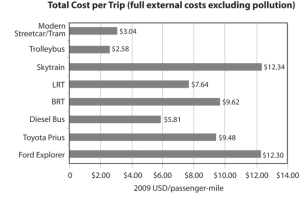Why a Streetcar Is Something to Be Desired - Rule 1 for sustainable communities: Restore the streetcar city (The Tyee, Sept. 16, 2010)

The article reviewed today has an excerpt from Patrick Condon's new book “Seven Rules for Sustainable Communities: Design Strategies for the Post Carbon World”. It contains a comparative cost analysis for LRT, bus and streetcar from Vancouver, concluding that the mode that best supports shorter walk trips- so-called pedestrian accelerator – has the optimal benefits in terms of capital costs and operating costs. An important point is made for cities such as Ottawa that suffer from long periods of car-dependency and extended sprawl where public transit must meet the need for long distance travel with relatively few stops – the result being a high overhead compared to the simple but cost-effective streetcars and trolley buses that were abandoned 50 years ago. The cost of pollution is not included but if it had been, even more reasons would likely be found to support electric transit, especially in areas where the power is largely generated from non-polluting, renewable sources such as hydro, nuclear or wind (as it is in Ontario).
Key Quotes
“U.S. and Canadian cities built between 1880 and 1945 were streetcar cities.. By 1950, this system was utterly overthrown, rendered obsolete by the market penetration of the private automobile.. (Toronto is a rare example of a city where the streetcar lines remain largely intact).”
“Close to half of urban residents in the United States and Canada live in districts once served by the streetcar. In these neighbourhoods, alternatives to the car are still available and buildings are inherently more energy efficient (due to shared walls, wind protection and smaller average unit sizes)”
“It does us no good to shift car trips to transit if average transit trips become longer and longer over time. Eventually energy and resource reductions will be eaten up by increased vehicle miles travelled per person on these new transit vehicles”
“the walk trip is the mainstay mode of movement in streetcar neighbourhoods, with the streetcar itself acting as a sort of pedestrian accelerator, extending the reach of the walk trip”
“transportation modes encouraging land uses that support shorter trips (trolleybus and streetcar) are significantly more cost-effective than modes that facilitate more spread out land use patterns (i.e. modes designed for high speed, long distance trips)”
Related articles by Zemanta
- First Hill Streetcar Update: Preliminary Platform Design (seattletransitblog.com)
- Residents get glimpse of Charlotte streetcar project (charlotte.news14.com)
- A streetcar named retire? (thestar.com)
- The Great American Streetcar Myth (marketurbanism.com)
- Old Streetcars and Urban Transit (transitinutah.blogspot.com)
- Moving Toronto: Where the candidates stand (theglobeandmail.com)
- The Unnatural Demise (and Possible Revival) of the Baltimore Streetcar (streetsblog.net)


No comments:
Post a Comment